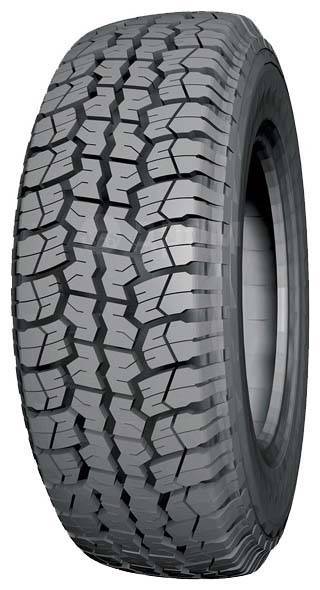The commercial vehicle segment demands tires that can handle daily abuse while maintaining reliability. Amtel’s Rapid River aims to meet these requirements with a bold approach to all-season performance. Unlike conventional commercial tires that prioritize highway comfort, these tires embrace an aggressive tread design that promises versatility across various terrains.
Light trucks and vans often face unpredictable conditions, from smooth highways to muddy construction sites. The Rapid River’s development focused on this reality, creating a tire that doesn’t shy away from challenging environments while maintaining practical daily usability.
Beyond the Pavement: The Rapid River Design Story
The Rapid River’s tread pattern tells a story of purposeful engineering. Large, independently positioned blocks dominate the design, creating a robust foundation for both on and off-road performance. This approach differs from competitors who often sacrifice off-road capability for highway comfort.
The symmetrical, non-directional tread pattern features four distinct block rows – two central and two shoulder zones. While this design might appear simple, it serves multiple purposes: reducing manufacturing costs, improving traction in various conditions, and maintaining reasonable noise levels on paved roads.
“These tires showed impressive durability during our fleet tests. After 6,000 kilometers of mixed use, they maintained consistent performance characteristics.” – Vladimir R., Fleet Manager
The shoulder blocks deserve special attention. Their aggressive design provides additional bite when needed, particularly useful when navigating loose surfaces or during tight maneuvers in confined spaces. The spacing between blocks also plays a crucial role in preventing mud accumulation.
Tackling Tough Terrain: Off-Road Capabilities
The Rapid River’s off-road performance reveals both strengths and limitations. The tire excels on packed dirt and gravel roads, where the large tread blocks provide stable grip and predictable handling. Self-cleaning capabilities become evident in these conditions, as the wide channels effectively eject stones and debris.
Here’s what makes the Rapid River suitable for mixed-terrain use:
- deep tread depth ensures extended service life even with frequent off-road use;
- reinforced sidewall construction protects against punctures and cuts;
- large void areas between tread blocks enhance loose surface traction;
- symmetrical design maintains performance in reverse maneuvers;
- optimized block spacing reduces mud retention.
However, extreme conditions expose certain limitations. In deep mud or loose sand, the tread pattern can become overwhelmed, requiring careful throttle management and momentum to maintain progress.
“For our delivery routes that include unpaved sections, these tires provide the reliability we need without compromising highway stability.” – Pavel T., Delivery Service Owner
On-Road Behavior: The Daily Driver Experience
Highway performance reveals the sophisticated side of the Rapid River’s design. Despite its aggressive appearance, the tire maintains acceptable noise levels at cruising speeds. The staggered tread block arrangement effectively breaks up road noise patterns, though some rumble remains noticeable above 100 km/h.
The following characteristics define the on-road experience:
- predictable steering response in dry conditions;
- reasonable wet-weather hydroplaning resistance;
- stable braking performance on paved surfaces;
- minimal vibration at highway speeds;
- acceptable comfort levels for commercial use.
Road feedback strikes a practical balance, providing enough information to gauge surface conditions without becoming tiresome during long drives.
Value Proposition: Cost vs. Performance
The Rapid River positions itself as a budget-conscious option in the commercial tire segment. Initial purchase price undercuts many comparable offerings from premium brands, making it attractive for fleet operators and small businesses watching their bottom line.
Many users report achieving 25,000-30,000 kilometers of service life under mixed-use conditions. While this falls short of premium alternatives, the lower acquisition cost often justifies the trade-off for many operators, particularly those who frequently encounter conditions that accelerate tire wear.
Making the Right Choice: Final Thoughts
The commercial tire market demands careful consideration of multiple factors. The Rapid River represents a compelling option for operators who need genuine off-road capability without sacrificing everyday usability. It’s not the most refined choice for purely on-road use, but its versatility makes it worth considering for mixed-service applications.
| Advantages (Pros) | Limitations (Cons) |
|---|---|
| Aggressive tread design provides good off-road traction | Highway noise increases noticeably at higher speeds |
| Competitive initial purchase price | Mud clearing capability could be better in extreme conditions |
| Durable construction with good puncture resistance | Wet braking performance lags behind premium competitors |
| Effective self-cleaning in moderate conditions | Shorter overall lifespan compared to premium options |
| Balanced performance in daily commercial use | Limited sizes available |
| Strong value proposition for mixed-service applications | Winter performance could be improved |
| Good stability on gravel and packed surfaces | Some users report difficulty with balancing |
The Amtel Rapid River emerges as a practical choice for commercial vehicle operators who need a tire that can handle occasional off-road excursions while maintaining reasonable on-road manners. Its aggressive design and durability make it particularly suitable for delivery services, construction companies, and small businesses operating in areas with varying road conditions.

